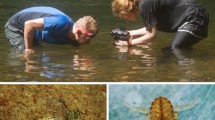Abstract
Traditionally, ecologists and taxonomists have conducted mostly separated research. Ecologists have been using the well-known species groups as their model organisms for practical reasons, whereas taxonomists have focused on poorly known species groups. Extensive collaboration between these research fields has unfortunately been a rarity. We argue that increased collaboration between ecologists and taxonomists yields benefits through several pathways. Firstly, it improves the scientific quality of both disciplines through deeper insight on the study organisms and increased feasibility of the collected data. Secondly, it improves the prospects of the scientists involved and opens up potential funding sources, helping to solve the taxonomic impediment. Finally, improved collaboration could balance ecological research towards more species-rich, functionally important groups. This would increase the quality and effectiveness of nature conservation and management plans positively affecting the sustainability of environmental policy making. These obvious benefits should be swiftly acknowledged by research institutions, science leaders and funding bodies. They should actively promote for strong collaborative efforts from the present and recruited staff representing both disciplines.
Similar content being viewed by others
References
Abrego N, Salcedo I (2015) Taxonomic gap in wood-inhabiting fungi: identifying understudied groups by a systematic survey. Fungal Ecol. doi:10.1016/j.funeco.2015.01.005
Agnarsson I, Kuntner M (2007) Taxonomy in a changing world: seeking solutions for a science in crisis. Syst Biol 56:531–539
Bebber D, Wood JRI, Barker C, Scotland RW (2014) Author inflation masks global capacity for species discovery in flowering plants. New Phytol 201:700–706
Bonnet X, Shine R, Lourdais O (2002) Taxonomic chauvinism. Trends Ecol Evol 17:1–3
Brito D (2004) Lack of adequate taxonomic knowledge may hinder endemic mammal conservation in the Brazilian Atlantic Forest. Biodivers Conserv 13:2135–2144
Brooks DR, McLennan DA (1991) Phylogeny, ecology and behavior: a research program in comparative biology. The University of Chicago Press, Chicago
Clark JA, May RM (2002) Taxonomic bias in conservation research. Science 297:191–192
Disney H (1998) Rescue plan needed for taxonomy. Nature 394:120
Dulvy NK, Reynolds JD (2009) The skates on thin ice. Nature 462:417
Ebach MC, Valdecasas AG, Wheeler QD (2011) Impediments to taxonomy and users of taxonomy: accessibility and impact evaluation. Cladistics 27:550–557
Evenhuis NL (2007) Helping solve the “other” taxonomic impediment: completing the eight steps to total enlightenment and taxonomic nirvana. Zootaxa 1407:3–12
Garrard GE, Bekessy SA, McCarthy MA, Wintle BA (2008) When have we looked hard enough? A novel method for setting minimum survey effort protocols for flora surveys. Austral Ecol 33:986–998
Gaston KJ, May RM (1992) Taxonomy of taxonomists. Nature 356:281–282
Giangrande A (2003) Biodiversity, conservation and the ‘Taxonomic impediment’. Aquat Conserv 13:451–459
Green SV (1998) The taxonomic impediment in orthopteran research and conservation. J Insect Conserv 2:151–159
Griffith GW (2012) Do we need a global strategy for microbial conservation? Trends Ecol Evol 27:1–2
Griffiths RA, Dos Santos M (2012) Trends in conservation biology: progress or procrastination in a new millennium? Biol Conserv 153:153–158
Halme P, Heilmann-Clausen J, Rämä T, Kosonen T, Kunttu P (2012) Monitoring fungal biodiversity—towards an integrated approach. Fungal Ecol 5:750–758
Hopkins GW, Freckleton RP (2002) Declines in the numbers of amateur and professional taxonomists: implications for conservation. Anim Conserv 5:245–249
Jones C (2008) Taxonomy sinking down under. Science 319:1601
Juslén A, Sirkiä S (2013) The unknown northern green: evaluation of a national forest biodiversity research program. Biodivers Conserv 22:811–823
Lee MSY (2000) A worrying systematic decline. Trends Ecol Evol 15:346
Li J (2009) China searches for an 11th-hour lifesaver for a dying discipline. Science 325:31
Mace GM (2004) The role of taxonomy in species conservation. Philos Trans R Soc Lond B 359:711–719
Rodman JE, Cody JH (2003) The taxonomic impediment overcome: NSF’S partnerships for enhancing expertise in taxonomy (PEET) as a model. Syst Biol 52:428–435
Ronquist F, Gärdenfors U (2003) Taxonomy and biodiversity inventories: time to deliver. Trends Ecol Evol 18:269–270
Salcedo I, Pieri M, Rivoire B (2004) Contribución al conocimiento de los Polyporales s.l. de Navarra. Boletín de la Sociedad Mocológica de Madrid 28:169–177
Stein BA, Master LL, Morse LE (2002) Taxonomic bias and vulnerable species. Science 297:1807
Sutherland WJ (2006) Ecological census techiques a handbook, 2nd edn. Cambridge University Press, Cambridge
Tellería MT (2002) Riqueza fúngica de la Península Ibérica e Islas Baleares: El proyecto “Flora Micológica Ibérica”. In: Pineda FD, Casado MA, de Miguel JM, Montalvo J (eds) La diversidad biológica de España. Prentice Hall, Madrid, pp 153–160
Wheeler Q (2014) Are reports of the death of taxonomy an exaggeration? New Phytol 201:370–371
Winfree R (2013) Global change, biodiversity, and ecosystem services: what can we learn from studies of pollination? Basic Appl Ecol 14:453–460
Acknowledgments
We are grateful to Nerea Abrego for comments on an earlier version of the manuscript. Panu Halme thanks Maj and Tor Nessling Foundation and Finnish Ministry of Environment for funding.
Author information
Authors and Affiliations
Corresponding author
Additional information
Communicated by David Hawksworth.
Rights and permissions
About this article
Cite this article
Halme, P., Kuusela, S. & Juslén, A. Why taxonomists and ecologists are not, but should be, carpooling?. Biodivers Conserv 24, 1831–1836 (2015). https://doi.org/10.1007/s10531-015-0899-3
Received:
Revised:
Accepted:
Published:
Issue Date:
DOI: https://doi.org/10.1007/s10531-015-0899-3




